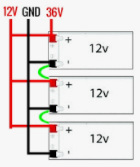Types of batteries and Used in components
A battery is a device that contains chemical energy, stores it, and converts it into electrical energy. There are some batteries that are made with cells connected in series.It was Alessandro Volta who invented the battery in 1800. With these batteries, the voltage fluctuated and there was an insufficient current.
A battery is a device that contains chemical energy, stores it, and converts it into electrical energy. There are some batteries that are made with cells connected in series.
It was Alessandro Volta who invented the battery in 1800. With these batteries, the voltage fluctuated and there was an insufficient current.
Types of Battery Materials
There are many types of batteries, that are categorized according to construction, size, and usage. But all the batteries are the source of DC voltage. The battery capacity depends upon its ampere value.
1- Nickel-cadmium
2 - Lithium ion
3- Zinc-carbon
4- Silver oxide
5- Lead-acid
There are many types of batteries, that are categorized according to construction, size, and usage. But all the batteries are the source of DC voltage. The battery capacity depends upon its ampere value.
1- Nickel-cadmium
2 - Lithium ion
3- Zinc-carbon
4- Silver oxide
5- Lead-acid
Nickel-Cadmium batteries
Nickel-cadmium batteries or NiCad batteries have a long service life and could last for years. But the disadvantage is the toxic material. However, it has the advantage of being unable to overcharge.
Lithium metal batteries
We use some batteries cell in small devices. We use the single cell in small devices, like digital watches, calculators, and car remotes that are button-shaped. Specifically, these batteries are silver-oxide, alkaline, and lithium-ion batteries.
We know these cells by their Code numbers, e.g. CR2016, CR2060, CR2450. This lithium battery is a metal-type cell with a 3V DC capacity.
Zinc-carbon batteries
We used it in toys, TV remotes, and clocks. It is a primary cell-type dry battery. It comprises zinc, manganese dioxide, and a carbon rod.
Through chemical reactions, the cell generates voltage. The carbon rod is used as an anode, and zinc is a cathode with negative polarity. AA type 1.5 cell is an example of zinc-carbon.
Silver-oxide batteries
Silver oxide is a combination of zinc and silver oxide. In these batteries, zinc serves as an anode and silver oxide as a cathode. An example of silver oxide in the battery is a button/coin cell. We use it in watches, calculators, and small electronic devices.
Silver oxide is a combination of zinc and silver oxide. In these batteries, zinc serves as an anode and silver oxide as a cathode. An example of silver oxide in the battery is a button/coin cell. We use it in watches, calculators, and small electronic devices.
Lead-acid batteries
Primary Cell
These types of cells can’t recharge. We use them in TV remotes, clocks, and toys. It is a one-time-use cell.
These types of cells can’t recharge. We use them in TV remotes, clocks, and toys. It is a one-time-use cell.
Rechargeable batteries
We know these as secondary batteries or rechargeable batteries. An example of this is a lead-acid battery. The dry type of cell is also rechargeable.
Rechargeable batteries are designed for drill machines, cars and motorbikes, and inverters.
We know these as secondary batteries or rechargeable batteries. An example of this is a lead-acid battery. The dry type of cell is also rechargeable.
Rechargeable batteries are designed for drill machines, cars and motorbikes, and inverters.
Battery Types by Sizes
1- Button Cell
The Button battery is small and button-shaped. We use it in hand-held calculators, wristwatches, and also toys.
The Button battery is small and button-shaped. We use it in hand-held calculators, wristwatches, and also toys.
2- AA batteries
5- C Type battery
C batteries are bigger than AA and AAA batteries but contain the same voltage. Their size is the only difference.
6- D Type Battery
7- 9V batteries
9V batteries are very famous in many electronic equipment. It has better power than other small cells, so we use it in scales, alarm circuits, and devices that require more power.
8- 23A batteries 12 volt
This is a small 12-volt battery of 23 Amp capacity. We use dry batteries in radio frequency or Wi-Fi-operated devices. RF-controlled remote required strong voltage to generate a radio frequency signal for switching. This is made with an alkaline material.
9- Cordless battery
Drill machine batteries consist of cells connected in series. Cordless batteries are lithium-ion types, used in power tools. It comes with 18V, 20V, 36V with 2.0AH, 4.0 AH, 5.0AH, 6.0AH, etc. These batteries are rechargeable and used for the long term.
Car batteries/inverter battery
Car or auto batteries comprise galvanic cells that are connected in series. We categorized them according to their size and ampere capacity. Wet cell batteries contain six cells, filled with sulfuric acid.
This type of battery life is almost two to three years. The battery replacement chart can also be helpful.
To get the best result, for long battery life, we should clean the terminal against debris. Car battery replacement is not a hard task.
We also know an Inverter battery as an automotive battery. There are different amperage levels, such as 63AH, 70AH, and 80AH.
Other types of best automotive batteries include dry cell types, such as AGM and lithium-ion. The dry battery replacement is very easy because it comes in small sizes.
Car or auto batteries comprise galvanic cells that are connected in series. We categorized them according to their size and ampere capacity. Wet cell batteries contain six cells, filled with sulfuric acid.
This type of battery life is almost two to three years. The battery replacement chart can also be helpful.
To get the best result, for long battery life, we should clean the terminal against debris. Car battery replacement is not a hard task.
We also know an Inverter battery as an automotive battery. There are different amperage levels, such as 63AH, 70AH, and 80AH.
Other types of best automotive batteries include dry cell types, such as AGM and lithium-ion. The dry battery replacement is very easy because it comes in small sizes.
Batteries in Serial Vs Parallel
We know that something connected batteries in series and parallel. But what is the reason for the scenario? In a simple example, in TV remote AAA batteries connected in series, increase the voltage from 1.5V to 3V.
So the series connections will increase voltage capacity. Parallel connection of batteries will increase amperage capability. We connected batteries in parallel, just as in industries, to provide a backup for voltage supplies.
We know that something connected batteries in series and parallel. But what is the reason for the scenario? In a simple example, in TV remote AAA batteries connected in series, increase the voltage from 1.5V to 3V.
So the series connections will increase voltage capacity. Parallel connection of batteries will increase amperage capability. We connected batteries in parallel, just as in industries, to provide a backup for voltage supplies.
Batteries charging time
The charging depends upon the size of the battery, and also the charging circuit ampere capacity. A drill machine battery will take less time than a car battery. Normally slow charging is better for the batteries' life.The formula of battery Charging(Lead Acid)
We can find the charging time by using the formula.
Battery charging time = Battery Amp / current Amp



















